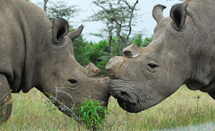When is the Best Time to Visit Masai Mara on Safari in Kenya?
Kenya's Masai Mara is one of the most iconic safari destinations in Africa. Home to the Maasai people, the Mara River crossing during the wildebeest great migration, BBC's Big Cat Diary, and Disney Nature's African Cats, the Masai Mara is the quintessential African safari destination. This post outlines the best time to visit Masai Mara on a safari in Kenya, to help you get the most out of your African safari.
Thronged with African wildlife from the Big 5 safari animals - lion, leopard, elephant, buffalo, and if you are lucky the shy and reclusive rhino to small gazelles, zebra, eland, giraffe, and more, the Masai Mara is safari gold. Choosing the best time to visit the Masai Mara National Reserve can seem daunting. Let's take a look at what you need to consider when planning your Masai Mara safari in Kenya.
 Cheetah in Masai Mara National Reserve
Cheetah in Masai Mara National Reserve
Masai Mara National Reserve at a Glance
Spanning over 1,510 sq km (580 sq mi) of the quintessential African savannah, the Masai Mara is the northernmost section of the Mara-Serengeti ecosystem, which covers a total of 25,000 sq km (9,700 sq mi) between Tanzania and Kenya. Although everyone wants to see the great migration, the Masai Mara is home to abundant resident (non-migratory) wildlife all year round. Add to this the temperate climate and other nearby safari gems and the Masai Mara National Reserve is considered an incredible year-round safari destination.
At a glance, Kenya has two rainy seasons: mid-March to June affectionately called the “long rains” and then the “short rains” from October to December. Safari high-season falls in the dry season from July to October. While November to March is considered the low safari season, it offers a quieter, slightly damper alternative that is perfect for photographers and bird watchers.
 Wildebeest crossing the Mara River
Wildebeest crossing the Mara River
The Masai Mara Great Migration in Kenya
Undoubtedly the best time to visit the Masai Mara is during the legendary great migration from July to October.
The Masai Mara dry season runs from June to November. This is when game viewing is at its best. The famous great wildebeest migration begins around July and is in full swing by August. The wildebeest mill about the Mara until October when they begin to leave with some stragglers departing as late as November. Be aware that the movements of the great wildebeest migration are dependent on East Africa's seasonal rainfall patterns. With all things 'wild' timing comes with a bit of luck and it's best to carefully consult and plan with one of our safari experts.
 Vultures on Masai Mara safari in Kenya
Vultures on Masai Mara safari in Kenya
However, there is a 'BUT' in this equation. Because of the popularity of the Masai Mara National Reserve and the great migration safari experience, Kenya is one of the busiest safari destinations in Africa. During the great wildebeest migration, there is a second migration of eager safari tourists jostling for the best position which means that these safaris can often be crowded. To counter the crowds there are two workarounds; planning your safari to coincide with the low safari season or heading for the Masai Mara conservancies.
Low Season in the Masai Mara
Outside of the safari high season, the Masai Mara delivers impressive populations of resident ungulates that remain in the Masai Mara all year round. Eland, impala, Thompson's gazelle, giraffe, topi, hartebeest, reedbuck, waterbuck, hippo, and warthog are all present. There are cheetahs, leopards, and large lion prides that prey on the game, all call the Masai Mara savannah home. While November to March is considered the low safari season, it offers a quieter, slightly damper alternative that is perfect for photographers and bird watchers.
By November, the short summer rains begin and the majority of the wildebeest herds continue south to the calving grounds of the Serengeti. November to May is the low season. December can have a lot of local festive season traffic while January is the best birding month. February is calving season with great predator action while in March lodges begin to close for the 'long rains'. March to May are generally cool, wet, and muddy and by June the Mara is lush and green, ready for the wildebeest herds that begin arriving in July.
Though this sounds matter-of-fact, weather patterns do shift and change and exact timings are almost impossible to predict.
Best Birding in the Masai Mara
For the Masai Mara birding bonanza, look to travel between November and April. This is the 'wet' season where afternoon showers are common. It is also a low safari season meaning better rates and lower volumes of traffic. It is the best time for birding because, in addition to the regular savannah species, the European and north African seasonal visitors have arrived too. The Masai Mara is a birder's paradise with over 500 documented species.
Perennial favourites include superb starlings, lilac-breasted rollers, and little bee-eaters as well as ostrich, ground hornbills, kori, and Denham's bustards. Forests along the banks of the Mara and Talek Rivers have must-sees like Ross's and Schalow's turaco. The Masai Mara is also famous for the almost 60 species of raptors from kestrels to vultures, buzzards, secretary birds, and the impressive long-crested eagle and the bateleur.
The Masai Mara: Concessions and Conservancies
Another way to work around the large volumes of peak safari traffic is to stay in one of the outlying conservancies or concessions. The Masai Mara can be simplistically divided into the Masai Mara National Reserve and the Masai Mara Conservancies.
 Masai Mara rhinos, Kenya safari
Masai Mara rhinos, Kenya safari
The Masai Mara National Reserve is government-owned and run. You must visit the Masai Mara National Reserve in order to see the great migration river crossings along the Mara and Talek Rivers. The downside here is that there are no restrictions on either the number of tourists in the national park or the number of vehicles at game sightings. The result can be a melee of safari vehicles that leave safari-goers in dismay.
 Great migration in Masai Mara, Kenya
Great migration in Masai Mara, Kenya
The conservancies that surround the Masai Mara are owned by the Maasai themselves. all income generated, therefore, returns to these communities and provides a real incentive to boost conservation. Private safari operators lease land from the conservancies to run their lodges and bush camps. These camps share traversing rights and are usually staffed by local Maasai people of Kenya. This deepens the cultural interactions which can be further augmented by visiting local villages for a small fee. All of the profits from your safari will be returned to the local people making this a safari win for communities, wildlife, and tour operators.
Unlike the Masai Mara National Reserve, tourist numbers in the conservancies are strictly controlled and vehicle numbers at game sightings are limited to 5. Within the conservancies, you can also do Maasai-guided bush walks, horse rides, and night drives.
Many safari enthusiasts who want to see the great migration herds crossing the Mara River, will often stay in the conservancies and do day trips into the national park. This is one-way traffic. Visitors to the national park are not allowed to enter the conservancies. Because tourist numbers in the Masai Mara conservancies are low the game is often more abundant and the safari experience more private and intimate.
 Hot air balloon ride over Masai Mara
Hot air balloon ride over Masai Mara
Practical Advice for Visiting the Masai Mara in Kenya
When you visit the Masai Mara, a fly-in safari is recommended. This is the quickest and safest way to get to the Masai Mara National Reserve from Nairobi.
The Masai Mara is serviced by almost 60 flights a week that will land you in the Masai Mara where you will be collected by your safari operator. Flights take around an hour while driving will set you back around 6 hours. The benefit of your fly-in safari is that your travel time is limited thus maximizing the time you spend on safari in the Masai Mara.
 Wildebeest river crossing Masai Mara
Wildebeest river crossing Masai Mara
Due to the popularity of the great migration safari, it is advisable to book for this up to a year in advance. It is recommended that you talk to a safari consultant to make sure you get the bespoke African safari package that you have always dreamed of.
Dress sensibly in cool neutral-coloured clothing. Black tends to be hot and attract mosquitoes while white gets grubby quickly. Loud colours startle wildlife and can be an insect magnet. Zip-off trousers and a warm shell jacket will allow you to keep warm on early morning and evening game drives but cool during the heat of the day.
Always stay hydrated and drink lots of water.
 Lion hunting zebra in Masai Mara of Kenya
Lion hunting zebra in Masai Mara of Kenya
The Best Time to Visit the Masai Mara...
The Masai Mara in Kenya is considered to be an all-year-round safari destination. If you want to see the Mara River crossing during the great migration, book between July and October. If birding is your thing, November to April with January being the best month. If you are just looking to experience the vast African plains you can do a Big 5 safari all year round.
Compare our affordable Masai Mara Safari Packages to find the trip that suits you and book online. Or, talk to one of our experienced travel consultants at African Budget Safaris today to figure out the best safari time for you.
If you liked this post, these trips cover similar ground…
- 3 Day Fly-in Masai Mara Safari to Exclusive Camp
- 4 Day Fly-in Masai Mara Safari in Kenya - Tented Camping
- Budget Kenya Safari - Masai Mara & Beyond
- 5 Day Fly-in Kenya Safari in Masai Mara Conservancy Areas
- 10 Day Kenya to Tanzania Tour - Best Parks, Masai Mara & Serengeti Safari
- 10 Day Kenya Safari - Masai Mara & Samburu Senior Trip








 On the outskirts of Marloth Nature Reserve, Andrew can be found walking and swimming in the beautiful Langeburg Mountains. He is passionate about animals, birds, reptiles, and plants and loves nothing more than an adventure in nature. An established artist with a master's in English literature, Andrew has traveled far and wide but South Africa still has his heart.
On the outskirts of Marloth Nature Reserve, Andrew can be found walking and swimming in the beautiful Langeburg Mountains. He is passionate about animals, birds, reptiles, and plants and loves nothing more than an adventure in nature. An established artist with a master's in English literature, Andrew has traveled far and wide but South Africa still has his heart.












